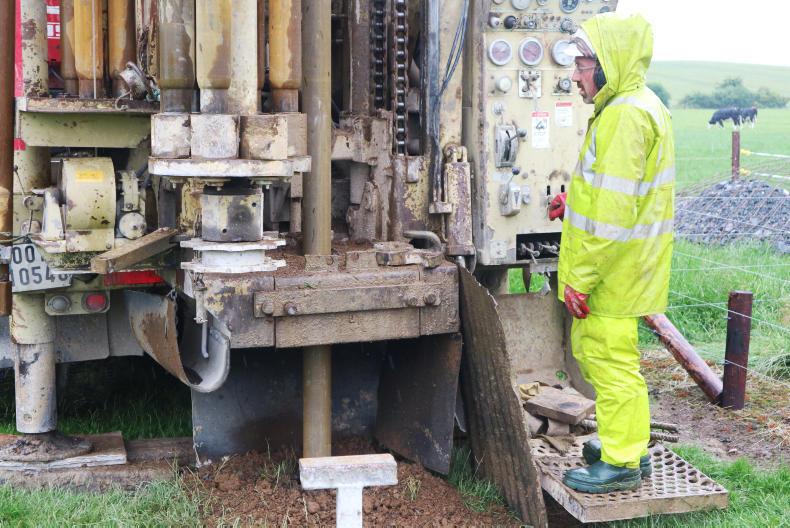Last week the Irish Farmers Journal visited Corey McKeever’s farm in Shanlis, Ardee, Co Louth.
A new well was in the process of being sunk on the farm to supply water for his beef and sheep enterprise.
Well drilling specialists Tom Briody and Son from Kells, Co Meath, were installing the well on the farm.
Company director Hugh Briody said some farmers are interested in investing in the protection of newly drilled wells to prevent well water becoming polluted from the surface groundwater.

Hugh said his company can finish a well to suit any customer’s budget and requirements.
“We can seal up wells far better now to prevent ground water seeping into the water source and reducing the quality of the water,” explained Hugh.
Where customer’s budgets are more limited, the basic well can be installed without these sealants, according to Hugh.
The well on the McKeevers’ farm was being installed with this greater level of protection. Here we go through the process involved in drilling this type of well and the time it takes.
The site
Hugh says there are a number of considerations they take into account when choosing the site of a new well.
The EPA recommends you keep the borehole a safe distance from any pollution risks in the farmyard.
Access is a big consideration because the drilling rig cannot travel on every type of terrain. Wet weather makes access more difficult.

Rubber mats are useful in a lot of cases but if there is a considerable hill the mats might not work. Sometimes a farmer might put down a temporary roadway so the rig can travel to the site.
Hugh says ideally he tries to avoid depressions in the ground, the area should be close to a power source and well away from animal housing or septic tanks.
“You should site the well where it won’t be at risk of contamination but still close enough to the farmyard for convenience” he explained.
Hugh says they don’t rely on divining and are happy to drill once the site fits the criteria mentioned earlier. “You really don’t know what you are going to hit until you dig,” he explained.
“We obviously cannot set up where there are overhead power lines because the tower of the rig is 45ft high and we have to be careful of underground electricity or gas mains too,” said Hugh.
The drilling rig was set up in a dry area at the back of Corey’s farmyard.
Drilling
The drill bit on the rig is rotating constantly as it enters the ground.
Air is simultaneously being pumped into the drill bit to create a hammer affect allowing the drill to get through hard material such as boulder clay and bedrock.
Drill cuttings of clay and bedrock are brought to the surface via pumped air. The graphic shows the different depths the borehole for the well was dug on Corey’s farm.

The first part of the borehole was drilled at 12in diameter to a depth of 42ft, through boulder clay and bedrock.
A 10in steel casing was then placed in this section. From there, they drilled a hole 10in in diameter from 42ft to 57ft.
A 6in tubular steel casing was placed in this section and centred in the borehole. This left a void of 2in between the bedrock and the steel casing.
A cement grout seal was placed in this void to help prevent groundwater seeping from above straight into the water source. From there, a 6in diameter open borehole was drilled from 57ft to 220ft.

When the drilling is over, the well is air developed (cleaned) and the water supply is monitored. In this well Corey was fortunate enough to have a supply of 750 gallons/hour.
Hugh says this is a good supply. He said supply can vary from 30 gallons/hour to as high as 10,000 gallons/hour.
A dairy cow can drink 90l of water a day, a beef animal can drink 45l/day and a sheep can drink 20l/day.
When the well is air-developed, 220ft of 5in slotted PVC liner is fitted from top to bottom. The well liner protects the borehole and it also protects the submersible pump, cable and piping.
Pumping
The size of the submersible pump used depends on the requirements of the farm and dwelling house and it also depends on the depth of the well.
A 1.5hp pump was used on Corey’s farm which can deliver 40l to 50l of water per minute on average. The pump is suspended by a nylon rope.
Hugh says it is very important that the headworks of the well (where the well meets the surface) is above ground. He uses a stainless steel cap to protect the top of the well from vermin.

In the shed nearby a 200l pressure vessel will be fitted. The pressure vessel is a great way of reducing the amount of times the pump has to cut in/out.
It is only when the pressure in the vessel drops below a certain level that the pump switches on to replace the water used and build pressure in the vessel again.
Hugh says all existing pumps and pressure vessels on farms should be serviced at least once annually.
A full service costs €150 and during the service checks are carried out on pressure vessels to ensure they are not leaking air.
Cost
To bore a new standard 200ft deep well, install standard casing, supply and fit the new pumps costs €5,000 excluding VAT.
Farmers get the VAT back for well drilling. Hugh says it costs approximately €2,000 excluding VAT more to seal a well using his technique mentioned earlier.

Usually it takes two days to dig a well and fit the steel casings.
It takes another day to fit the pump and pressure vessel. He says all new wells are disinfected with chlorine to EPA guidelines to kill off any bacteria that might be present.
Increased water demand puts water and septic tanks under pressure